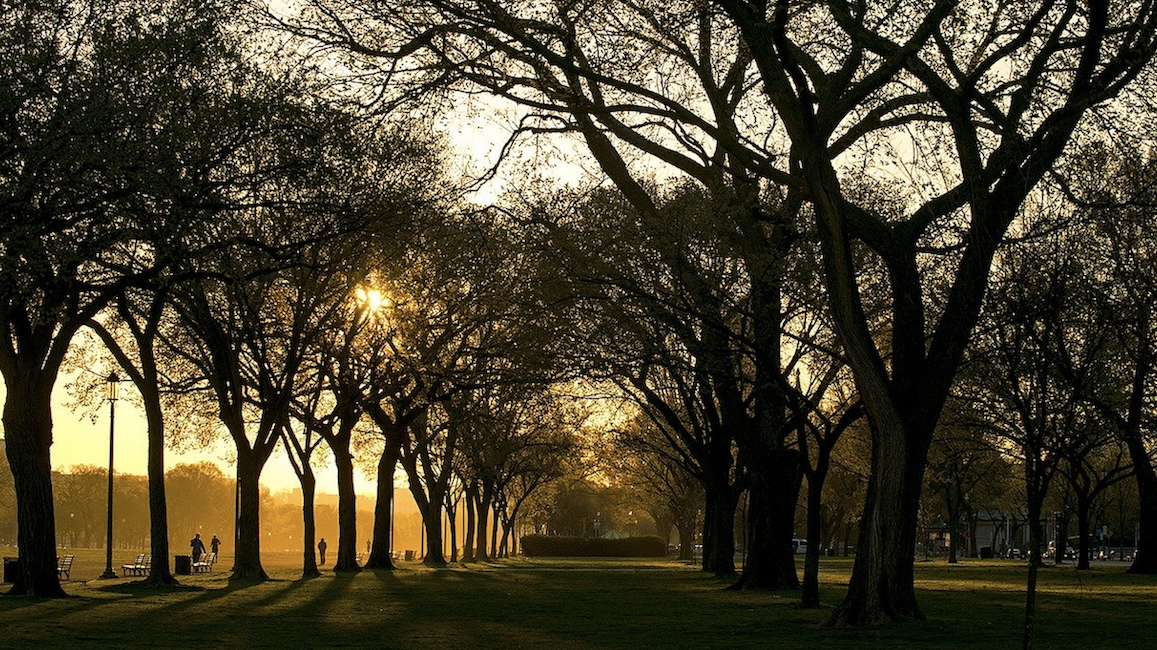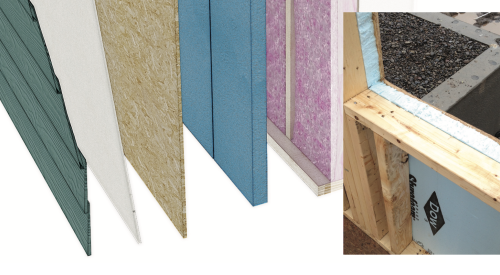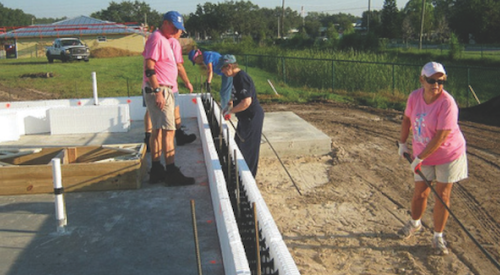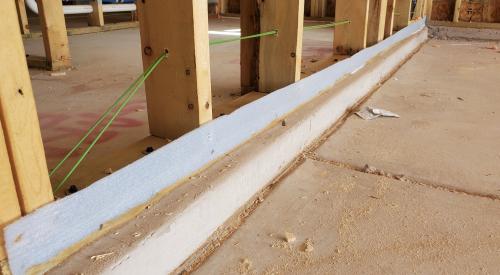Builders have had to contend with the effects of rain and humidity on the homes they build for as long as homes have been built. But moisture control has become an even bigger issue in home building as houses have gotten tighter and more energy efficient — air-sealing measures and additional insulation in exterior walls creates colder walls that are less able to dry naturally when they become wet.
This makes the design of the wall assembly vitally important, not only to keep moisture from getting into the exterior walls, but also to let any that does get in escape or dissipate in some way. What’s the most effective combination of structural sheathing and exterior cladding to help avoid excess moisture in exterior walls?
To answer that question, the NAHB Research Center conducted a two-year field investigation of nine different pairs of north- and south-oriented, wood-framed wall assemblies. The study objective was to quantify the field performance of wood-frame walls clad with a variety of common claddings in a mixed-humid climate, as well as identify the relative capabilities of the different wall assemblies to dissipate moisture when they did become wet.
The study was conducted on the suburban Maryland campus of the NAHB Research Center, located 20 miles east of Washington, D.C., in a mixed-humid climate. The mixed-humid climate is defined as having:
- More than 20 inches of annual precipitation,
- Fewer than 5,400 annual heating degree days (base 65 degrees F), and
- An average monthly winter temperature below 45 degrees F.
Every climate has its own characteristics to be considered when designing a wall system. The mixed-humid climate has unique and dynamic conditions related to moisture control — moisture migration from the inside of a structure during the winter and from the outside during the summer — which can be problematic for certain wall assemblies.
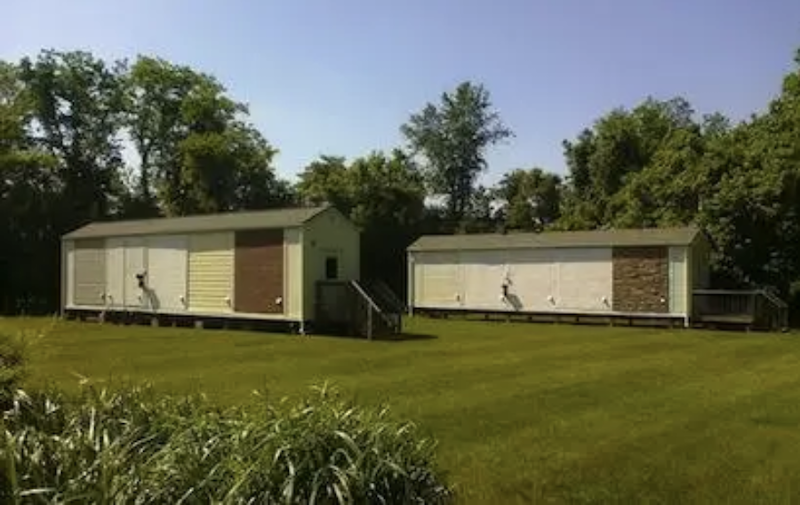
The claddings used in the study include traditional stucco, fiber-cement siding, brick veneer, manufactured stone, vinyl siding, and insulated vinyl siding. These materials account for nearly 90 percent of those typically used in residential construction in the U.S. Moisture content of the sheathing (either OSB or plywood) and wall cavity temperatures were measured in each wall section at various points throughout the study. Some of the wall assemblies differed substantially in both cladding type and moisture handling, while others were similar in type and appearance, but differed with regard to their moisture drainage design.
To test the various wall sections, the Research Center performed controlled injections of water behind the cladding at set intervals throughout the research duration. Some walls were less able to drain or otherwise dissipate the injected water than others, but all performed satisfactorily in terms of the standard industry moisture content levels (see sidebar).
Under normal weather exposure, the studs and sheathing in all walls tested remained well below 20 percent moisture content, which is the long-accepted industry threshold for wood decay. That said, stucco-clad walls with only one layer of water-resistive barrier (WRB) had the least ability to dissipate injected water. Walls with manufactured stone cladding and two layers of WRB were better able to dissipate injected water than the stucco walls with one layer of WRB, but not as effective in doing so as the other cladding systems. Insulated vinyl siding, traditional vinyl siding, and brick were the three driest claddings tested.
Optimal Building Practices in a Mixed-Humid Climate
If you are building homes in a mixed-humid climate region, the following practices can be considered optimal for preventing excessive moisture content in wood framing members and structural sheathing.
• Only build walls that face south. While this is obviously not a realistic strategy given most homeowners’ nagging desire for a three-dimensional home, south-facing wall sections did perform best in terms of dissipating behind-the-wall moisture resulting in dryer sheathing. Why? Because they got more long-term, direct exposure to the sun throughout the day. To take it a step further, darker-colored (manufactured stone and brick veneer) south-facing walls in the study performed even better, because they absorbed more warmth from the sun than lighter-colored walls with the same orientation, thereby increasing the walls’ ability to dry.
• Install two layers of WRB. When there were no “leaks” injected into the wall sections, those with one layer of WRB (felt) and those with two layers performed equally well. However, when leaks were simulated, walls with two layers of felt performed much better at shedding moisture.
• Use non-absorptive claddings. Walls with non-absorptive cladding (vinyl siding and insulated vinyl siding) had among the lowest sheathing moisture content recorded in the study; this was the case for walls that faced either north or south.
The complete findings of this research will be presented in December at the Thermal Performance of the Exterior Envelopes of Whole Buildings XI International Conference in Clearwater, Fla. A preliminary summary can be found on the NAHB Research Center’s ToolBase website, and the final report will be available through ASHRAE in 2011.
Wood Moisture Thresholds: What Are They All About?
Wood building materials and assemblies constructed of wood or wood-based products perform best when they remain dry. For this reason, there are industry-established moisture thresholds for wood products relative to decay, rated structural performance, and mold growth.
Prominent organizations in the wood industry have defined a dry condition for engineered wood products (EWP) — i.e., plywood, oriented strand board — as moisture content of less than 16 percent, and for solid wood of less than 19 percent. These levels relate to rated structural performance. The reason the moisture content threshold is set lower for engineered wood products than for solid wood is that engineered wood products have lower equilibrium moisture contents than solid wood at equivalent relative humidity conditions. When wood products are used in conditions where moisture contents exceed these threshold levels, the National Design Specification requires that Wet Service Factors be applied. The service factors de-rate the design values for material strength and stiffness. Engineers apply these factors when they expect that in-service moisture conditions will exceed the thresholds.
The same moisture threshold value that determines application of Wet Service Factors is also assumed by the wood products industry to be the upper limit of in-service moisture content limit for wood-based structural panels. The industry applies the same assumed limit to in-service moisture content of both plywood and OSB panels.
In fresh, uninfected wood and wood products, decay is only likely to be established when moisture content exceeds the fiber saturation point (average 30 percent MC in lumber) at temperatures between 50 F and 95 F. The long-recognized 20 percent threshold provides a margin of safety with regard to preventing the spread of decay.
Thresholds for mold growth have been established in the first edition of ANSI/ASHRAE Standard 160-2009: Criteria for Moisture-Control Design Analysis in Buildings, defined as “conditions necessary to minimize mold growth.” The values in the standard translate to lower maximum allowable in-service moisture contents for engineered wood products than the value assumed by the industry (APA 2002). The mold growth prevention criteria outlined in ASHRAE Standard 160 consist of three parameters: time, temperature, and surface relative humidity. The criterion with the longest time duration element (30-day running average) specifies that surface relative humidity not exceed 80 percent. This corresponds with a solid wood moisture content of 16 percent, which approximately equates to a plywood MC of 14 percent and OSB MC of 13 percent.
Created in 1964, the NAHB Research Center is a full-service product commercialization company that strives to make housing more durable, affordable, and efficient. The Research Center provides public and private clients with an unrivaled depth of understanding of the housing industry and access to its business leaders.
